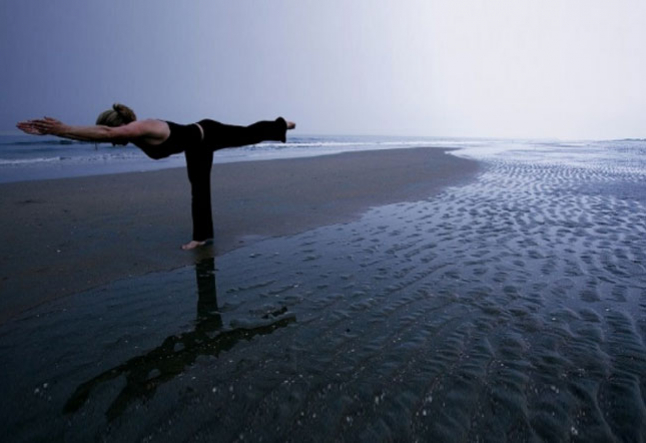yoga and the right & left hemispheres of the brain

translating and transcending language in our yoga practice.
What language do you speak?
The fact that you are reading these words suggests that English is at least one of your languages. A Germanic tongue with Norse, Latin, Greek and Norman-French imports and influences, it’s a language that continues to assimilate new words into its vocabulary. But however adaptable and varied English is, you are unlikely to satisfy your thirst in China by asking for a glass of water (wo neng you yo bei shui might get you closer).
This is how it is in yoga – only here we find the problem arising when one hemisphere of the brain wrongly interprets language meant for the other. Put simply, the brain is split into distinct halves, or hemispheres: the right and the left. Physically these are almost entirely separate, except for the area at the corpus callosum where the two interconnect and communicate with one another.
Scientists have found the functions of the two hemispheres are equally discrete. The left side of the brain is logical, systematic and ordered, and is involved in processing, patterning, defining, and describing. It is sometimes described as being more ‘masculine’ or ‘yang’ and is involved in language and analysis. Meanwhile, the right hemisphere is more intuitive, immediate and sensory, acting instinctively and without words and concepts. It comes into play when we sense or feel something, described as ‘feminine’ or ‘yin.’
In other words, what is understood by the left brain may mean very little to the right, and vice versa. (See Jill Bolte Taylor’s A Stroke of Genius TED Talk).
In yoga, it is a classic mistake for a practitioner to try to understand an instruction aimed at the right, intuitive side of the brain with the logical left. Because working with the body requires a present-moment immediacy and responsiveness, yoga instructions are usually couched in right hemisphere language.
The right brain learns kinesthetically from physical experience, and its holistic, intuitive approach works best when dealing with the body, breath, or anything which needs to be processed in a non-abstract, here-and-now way.
Anything in a state of flux and flow cannot be reconciled with the most fixed views and opinions of the left hemisphere.
So, for example, when your yoga teacher tells you to “touch the floor with the inner edge of the big toe base,” or to “breathe into the lower back,” or “allow your thigh bones to drop out of the way of the pelvis,” these are not instructions to be followed logically by the left brain. Trying to get it in a rational way will only leave you confused or frustrated, and may even lead you to give up yoga, look for another teacher, or simply tune out the namby-pamby bits.
Instead, yoga asks you not to think but to be. In a back arch, you might be told to “pull the breast bone over while keeping the belly firm, drawing the pelvis over to lengthen the lumbar, sucking the side ribs in, and pulling the front body over the back.” These are not instructions to be ticked off linearly, in a left-brain way. They are designed to be felt, to be applied intuitively, to be experienced.
Similarly, you might be asked to “release any pressure from the brain” when practicing pranayama, or to “visualise the breast bone floating… like a buoy on a calm sea” while you “release the legs into the breath” during seated meditation.
Again, these are not actions that can be instigated by the left brain; they require the subtle, more intuitive interpretation of the right hemisphere.
Once we allow the right brain to receive right brain instructions, we find the truth of the motto, “calmness conditions connection.” The left will naturally follow the lead of the right. The flow from the right brain to the left allows a harmony to arise, where intelligence can grow through the experience without being stifled by the past. This view is mirrored in the words of the great sage Patanjali, stiram, sukham Äsanam, which describes the importance of steady, easy awareness in yoga postures.
Patanjali further says: “Practice and non-reaction are required to still the patterning of consciousness; otherwise consciousness takes itself to be that patterning.” He is clearly stating that non-reaction, or ease, is necessary to avoid the immediacy and awareness of the right hemisphere from being blocked by the restrictive interpretations of the left.
Some two centuries earlier, the Buddha had something similar to say on the subject: “People get bogged down in words like an elephant stuck in the mud.” Words (the realm of the left brain) can get in the way of our (right brain) understanding of the present moment. We need to experience without analysing.
How can we hope to balance the infinite inter-play between multifarious relationships that affect the body; a misleading term that, the left hemisphere thinks, defines an objectively autonomous and discreet region?
A more surrendered state is the key; a giving attitude, that leaves us available to receive and respond as our left brain agenda is relinquished and the psychic noise floor is brought down.
As Saint Augustine says, “You can’t put the ocean into your cup you must throw your cup into the ocean.”
Ultimately, the base level of experience is reached, a sort of ultimate substratum, through a profound stillness around whatever is arising in consciousness now. It brings with it an immediate response that is uncluttered and is able to dance with all the infinite nuances.
This base level, pure consciousness itself, is described so clearly by the great yogic sage Patanjali when he says “tatra niratisayam sarvajnabijam; The seed of All Knowing in that Unsurpassed.”
You can find out more about Jim’s teaching at Jim Tarran – Vajrasati Yoga
Jill Bolte Taylor’s A Stroke of Genius TED Talk
Check this out! Is your peace dependent on your brain?


